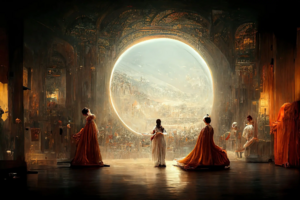Generative artificial intelligence facts for kids
Generative artificial intelligence (also generative AI or GenAI) is artificial intelligence capable of generating text, images, or other media, using generative models. Generative AI models learn the patterns and structure of their input training data and then generate new data that has similar characteristics.
Generative AI has uses across a wide range of industries, including art, writing, software development, product design, healthcare, finance, gaming, marketing, and fashion. Investment in generative AI surged during the early 2020s, with large companies such as Microsoft, Google, and Baidu as well as numerous smaller firms developing generative AI models. However, there are also concerns about the potential misuse of generative AI, including cybercrime or creating fake news or deepfakes which can be used to deceive or manipulate people.
Modalities
- Text
World knowledge in hand,
Infinite pages unfold,
Wisdom's vast, free land.
Generative AI systems trained on words or word tokens include GPT-3, LaMDA, LLaMA, BLOOM, GPT-4, and others (see List of large language models). They are capable of natural language processing, machine translation, and natural language generation and can be used as foundation models for other tasks. Data sets include BookCorpus, Wikipedia, and others (see List of text corpora).
- Code
In addition to natural language text, large language models can be trained on programming language text, allowing them to generate source code for new computer programs. Examples include OpenAI Codex.
- Images
Producing high-quality visual art is a prominent application of generative AI. Many such artistic works have received public awards and recognition.
Generative AI systems trained on sets of images with text captions include Imagen, DALL-E, Midjourney, Adobe Firefly, Stable Diffusion and others (see Artificial intelligence art, Generative art, and Synthetic media).
- Music
Generative AI systems such as MusicLM and MusicGen can be trained on the audio waveforms of recorded music along with text annotations, in order to generate new musical samples based on text descriptions such as a calming violin melody backed by a distorted guitar riff.
- Video
Generative AI trained on annotated video can generate temporally-coherent video clips. Examples include Gen1 and Gen2 by RunwayML and Make-A-Video by Meta Platforms.
- Molecules
Generative AI systems can be trained on sequences of amino acids or molecular representations such as SMILES representing DNA or proteins. These systems, such as AlphaFold, are used for protein structure prediction and drug discovery. Datasets include various biological datasets.
- Robotics
Generative AI can also be trained on the motions of a robotic system to generate new trajectories for motion planning or navigation. For example, UniPi from Google Research uses prompts like "pick up blue bowl" or "wipe plate with yellow sponge" to control movements of a robot arm. Multimodal "vision-language-action" models such as Google's RT-2 can perform rudimentary reasoning in response to user prompts and visual input, such as picking up a toy dinosaur when given the prompt pick up the extinct animal at a table filled with toy animals and other objects.
- Planning
The terms generative AI planning or generative planning were used in the 1980s and 1990s to refer to AI planning systems, especially computer-aided process planning, used to generate sequences of actions to reach a specified goal.
Generative AI planning systems used symbolic AI methods such as state space search and constraint satisfaction and were a "relatively mature" technology by the early 1990s. They were used to generate crisis action plans for military use, process plans for manufacturing and decision plans such as in prototype autonomous spacecraft.
Software and hardware
Generative AI models are used to power chatbot products such as ChatGPT, programming tools such as GitHub Copilot, text-to-image products such as Midjourney, and text-to-video products such as Runway Gen-2. Generative AI features have been integrated into a variety of existing commercially-available products such as Microsoft Office, Google Photos, and Adobe Photoshop. Many generative AI models are also available as open-source software, including Stable Diffusion and the LLaMA language model.
Smaller generative AI models with up to a few billion parameters can run on smartphones, embedded devices, and personal computers. For example, LLaMA-7B (a version with 7 billion parameters) can run on a Raspberry Pi 4 and one version of Stable Diffusion can run on an iPhone 11.
Larger models with tens of billions of parameters can run on laptop or desktop computers. To achieve an acceptable speed, models of this size may require accelerators such as the GPU chips produced by Nvidia and AMD or the Neural Engine included in Apple silicon products. For example, the 65 billion parameter version of LLaMA can be configured to run on a desktop PC.
Language models with hundreds of billions of parameters, such as GPT-4 or PaLM, typically run on datacenter computers equipped with arrays of GPUs (such as Nvidia's H100) or AI accelerator chips (such as Google's TPU). These very large models are typically accessed as cloud services over the Internet.
In 2022, the United States New Export Controls on Advanced Computing and Semiconductors to China imposed restrictions on exports to China of GPU and AI accelerator chips used for generative AI. Chips such as the Nvidia A800 and the Biren Technology BR104 were developed to meet the requirements of the sanctions.
Regulation
In the European Union, the proposed Artificial Intelligence Act includes requirements to disclose copyrighted material used to train generative AI systems, and to label any AI-generated output as such.
In the United States, a group of companies including OpenAI, Alphabet, and Meta signed a voluntary agreement with the White House in July 2023 to watermark AI-generated content.
In China, the Interim Measures for the Management of Generative AI Services introduced by the Cyberspace Administration of China regulates any public-facing generative AI. It includes requirements to watermark generated images or videos, regulations on training data and label quality, restrictions on personal data collection, and a guideline that generative AI must "adhere to socialist core values".
See also
 In Spanish: Inteligencia artificial generativa para niños
In Spanish: Inteligencia artificial generativa para niños



